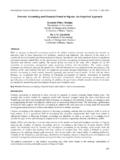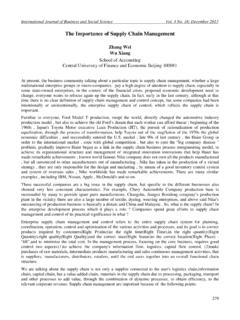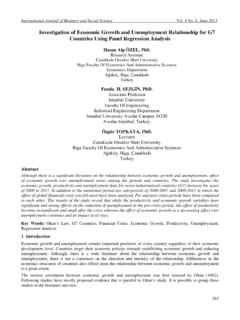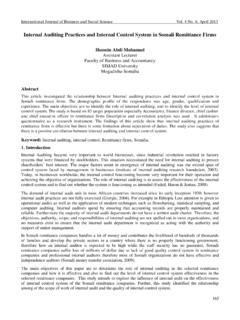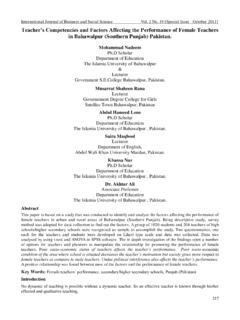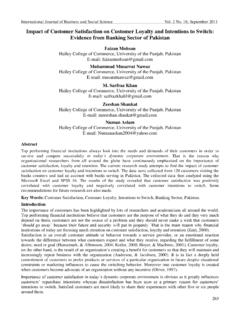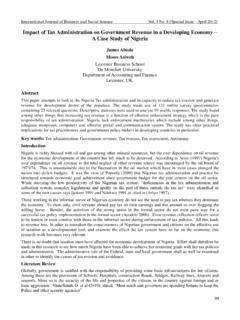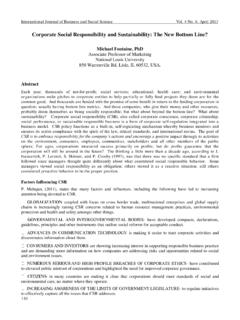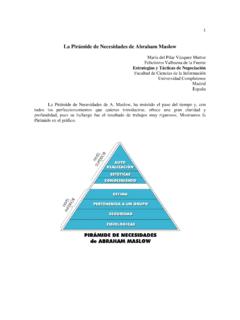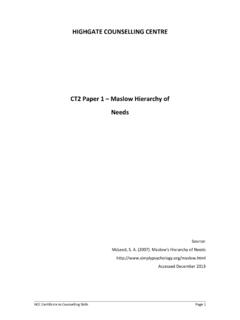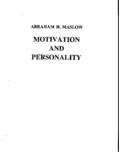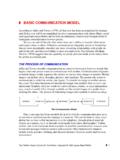Transcription of A Managerial Point of View on the Relationship between of ...
1 International Journal of Business and Social Science Vol. 5, No. 7; June 2014 207 A Managerial Point of view on the Relationship between of maslow s Hierarchy of Needs and Herzberg s Dual Factor Theory Zeynep Ozguner Doctoral Program, Institute of Social Sciences Hasan Kalyoncu University Havaliman Yolu zeri 8. Km. Gaziantep Turkey Mert Ozguner Prelector, Department of Management and Organization Ad yaman University Ad yaman, Turkey. Abstract This paper aims to investigate the Relationship between maslow 's hierarchy of needs, and Herzberg's dual factor theory. Thus, the details that will contribute to management is intended to achieve. The literature research was conducted for this paper. There is a fairly close Relationship between maslow s hierarchy of needs theory and Herzberg s motivation hygiene theory.
2 According to this study, if two theories of motivation are applied together to organization, it will be more effective. These theories of motivation are a good idea to implement this. Theories of motivation in order to avoid a sense of harmony within the organization, increasing burnout, and should be known. This article aims to provide insight for both theories of motivation. Keywords: maslow s Hierarchy of Needs, Herzberg s Dual Factor Theory, Motivation-Hygiene, Management Introduction The concept of motivation, according to management science literature, known as encouragement or motivation of personnel management is a key. If we think of it as a process, motivation is potential pre-determined targets, directing the work of staff in order to provide a process to be put in personal and Managerial expectations.
3 Motivation is the way managers act to promote a variety of motives in order for the employees to realize the objectives of the organizations. Administrators must deal with the issue of motivation. Because the success of the manager depends on how well he directs the knowledge and skills of employees to work for the purposes of the organizations. The objectives of the organizations and expectations and aspirations of the employees should be combined at a common Point . Administrators should being an agreement and cooperation with staff. The purpose is to increase the efficiency of the employee's capabilities so that the importance of motivation to take advantage of the maximum level should not be forgotten. An administrator should refer employees to behave so as to realize the objectives of the organization. It is very important to take advantage of theories of motivation in order to increase the efficiency within the organization and employees adaptation by analyzing the psychology of employees.
4 In other words, the performance is very closely related to motivation. Unmotivated staff shouldn t be expected to perform well. Because it's hard work to understand human behavior. People who want to reach fulfillment in personal life and business life are difficult to understand. They do not know their own needs. Even if they knew, they would not express them. Even so when the need is not met, people get unhappy. Because for most of human life, he/she wants to be motivated. He/she waits to be motivated. The prior need is to meet physiological needs. If you ask what is heaven for a man who is hungry, he would say it is a place full of food. Everyone is motivated by the need. If you have problems related to marriage, for example, to achieve the sales target will not satisfy you. Conceptual Basis of the Study Employees' job dissatisfaction common problem.
5 That is the issue of staff motivation! Not only in terms of employees, but also for ordinary people satisfaction is one of the prior issues discussed in the literature of management science topics. For this reason, quite a lot of research on the various theories were developed and made. Center for Promoting Ideas, USA 208 Self-actualization needs 1. maslow s Hierarchy of Human Needs The scientific motivation theory was addressed by Abraham maslow for the first time. maslow argued that people have some needs because they are social and psychological entities and that people have to satisfy these needs. They are analytically classified as, physiological, security, of belonging to a group, as the need for love and creativity.
6 maslow model is aimed to explain human motivation and employees' personal development needs. This theory is explained by maslow pyramid. Figure 1: Opportunities for Satisfaction in maslow s Hierarchy of Human Needs (Schermerhorn, 2001: 286) What satisfies higher order needs? What satisfies lower order needs? maslow s ideas are very helpful for understanding the needs of people at work and for determining what can be done to satisfy them. His theory advises managers to recognize that deprived needs may negatively influence attitudes and behaviors. By the same token, providing opportunities for need satisfaction may have positive motivational consequences. Figure 1 gives some examples of how managers can use maslow s ideas to beter meet the need of their subordinates. Notice that the higher order self-actualization needs are served entirely by intrinsic rewards.
7 The esteem needs are served by both intrinsic and extrinsic rewards. Lower order needs are served solely by extrinsic rewards (Schermerhorn, 2001: 285-286).Though there obviously are individual differences, many psychologists believe that there are certain patterns or configurations of human needs (Mondy, Holmes, and Flippo, 1940: 270). A common approach to establishing this need pattern is that of developing a unversal need hierarchy. Abraham maslow has proposed one widely accepted pattern which is illustrated in Figure 1. maslow states that individuals are motivated to satisfy certain unsatisfied needs. According to maslow s hierarchy of needs theory, an individual s needs are arranged in a hierarchy from the lower-level physiological needs to the higher-level needs for self-actualization. The physiological needs are the highest priority because until they are reasonably satisfied other higher level needs will not emerge to motivate behavior.
8 Physiological needs, it is generally agreed that the basic needs such as food, clothing, and shelter are our first concern. The organization helps individuals satisfy their basic needs by providing good salaries, benefits, and working conditions. Once these basic needs are satisfied to a reasonable degree, the individual then becomes aware of higher-level needs. Safety needs, once the physiological needs are reasonably well satisfied, the next higher level of needs becomes important as motivator. According to maslow , these are the needs for safety or security. These needs cause the individual to become concerned about security, protection from danger, and freedom from fear. In an organization, these needs may be satisfied by job security, benefit programs including insurance and retirement plans, and safe and healthy working conditions.
9 Social needs, these needs reflect an individual s desire for love, affiliation, and acceptance in Relationship with other people. In a work environment, social needs are concerned with relating to friendly associates, identification with a good company, and through participation in organized activities such as bowling or softball leagues, picnics, or parties. Esteem needs Creative and challenging work Participation in decision making Job flexibility and autonomy Responsibility of an important job Promotion to higher status job Praise and recognition from boss Social needs Friendly coworkers Interaction with customers Pleasant supervisor Safety needs Safe working conditions Job security Base compensation and benefits Physiological needs Rest and refreshment breaks Physical comfort on the job Reasonable work hours International Journal of Business and Social Science Vol.
10 5, No. 7; June 2014 209 Esteem needs, these needs represent the individual s concern for feeling important and respected by others. The esteem or ego needs relate to the need for achievement, recognition, and status. Individuals seek approval and recognition from others. Job title and responsibilities, praise, and competent management are all important factors in satisfying the esteem needs. Self-actualization, once esteem needs are reasonably well satisfied, the highest level of need, self-actualization, becomes important. Self-actualization or self-fulfillment is the need to realize one s capacities and potentialities by achieving specific goals. A person attempting to satisfy this need seeks challenging work assignments that allow for creativity and opportunities for personal growth and advancement. A person is never completely satisfied on any need level, but a sufficient amount of gratification of lower priority needs must be met if the individual is to seek to satisfy upper-level needs.
